From soaring skylines in East Asia to vertical expansions in the Middle East, skyscrapers have become defining features of modern urban landscapes. But not all cities build upwards equally. Some have turned high-rise architecture into a signature, driven by population density, land constraints, and economic ambition.
According to the Council on Tall Buildings and Urban Habitat (CTBUH), which maintains a database of high-rise structures, these are the cities with the highest number of completed buildings over 150 metres in height. The rankings, updated as of July 2025, offer a fascinating glimpse into where and why the world is building tall. These are the cities with the most skyscrapers.
The cities with the most skyscrapers in the world
1. Hong Kong: over 550 skyscrapers
No city in the world has embraced vertical living like Hong Kong. With over 550 completed buildings taller than 150 metres, the skyline is a forest of high-rises squeezed between mountainous terrain and the sea. A shortage of flat land, coupled with rapid economic growth in the late 20th century, made vertical development inevitable. Many of Hong Kong’s residential skyscrapers are tightly packed and uniform, while commercial landmarks like the International Commerce Centre and Bank of China Tower punctuate the skyline with dramatic architectural flair.
2. Shenzhen, China: over 380 skyscrapers
Shenzhen’s rise has been nothing short of meteoric. From a fishing village in the 1970s to a megacity with over 380 skyscrapers over 150m, it represents China’s model of hyper-urbanisation. Home to some of the tallest buildings in the world, including the Ping An Finance Center, Shenzhen’s vertical expansion is tightly linked to its identity as a tech and manufacturing powerhouse. The city’s skyscrapers are not just tall but often architecturally ambitious, part of a broader plan to position it as a global design hub.
3. New York City, USA: over 320 skyscrapers
Often credited as the birthplace of the skyscraper, New York still ranks among the top with over 320 high-rises over 150 metres. From the historic Chrysler Building to new icons like One World Trade Center and the pencil-thin towers of Billionaire’s Row, the city’s skyline has constantly reinvented itself. Zoning laws, air rights trading, and engineering breakthroughs have allowed for dramatic verticality. Unlike Asian counterparts, many of NYC’s skyscrapers blend commercial, residential, and institutional functions within a single footprint, reflecting the city’s layered, mixed-use urban fabric.
4. Dubai, UAE: over 250 skyscrapers
Dubai has become synonymous with architectural ambition, and its skyline is anchored by the world’s tallest building, the 828 metre Burj Khalifa. With more than 250 skyscrapers over 150m, the city’s vertical push has been largely driven by oil wealth diversification, tourism, and real estate speculation. Many towers in Dubai are concentrated along Sheikh Zayed Road and the Marina, blending luxury apartments, hotels, and office space in ever-taller structures. Sandwiched between sea and desert, Dubai’s rise to the top of global skylines has been both literal and symbolic.
5. Guangzhou, China: over 220 skyscrapers
Another Chinese city leading the skyscraper race, Guangzhou has over 220 completed towers exceeding 150 metres. As the capital of Guangdong province, it’s a key economic hub and trading centre with a long history. Skyscrapers here are clustered along the Pearl River and the Zhujiang New Town CBD, where landmarks like the Canton Tower and the Guangzhou International Finance Center rise. The city’s skyline reflects both historical depth and contemporary ambition, blending cultural motifs with cutting-edge design.
6. Shanghai, China: over 200 skyscrapers
Shanghai’s skyline is a symbol of modern China, with over 200 skyscrapers surpassing 150 metres. The city’s financial district in Pudong, once farmland, now houses architectural icons like the Shanghai Tower, Jin Mao Tower, and the Shanghai World Financial Center. Beyond Pudong, other districts like Lujiazui and Xujiahui are also seeing rapid vertical growth. Shanghai’s mix of futuristic towers, Art Deco mid-rises, and historic shikumen makes it one of the world’s most visually layered high-rise cities.
7. Tokyo, Japan: over 190 skyscrapers
Japan’s capital isn’t known for towering height due to strict seismic and zoning regulations, but it still boasts over 190 skyscrapers over 150m, an impressive feat in a country frequently rocked by earthquakes. Tokyo’s vertical growth has been strategic, concentrated in business hubs like Shinjuku, Marunouchi, and Roppongi. Its towers often prioritise structural resilience and design elegance, with standout buildings like the Toranomon Hills, Midtown Tower, and Shibuya Scramble Square. Even with height limitations, Tokyo’s skyline remains dynamic and futuristic.
8. Kuala Lumpur, Malaysia: over 180 skyscrapers
With around 180 completed skyscrapers, Kuala Lumpur is a Southeast Asian standout. Its skyline is defined by the Petronas Twin Towers, which held the title of the world’s tallest buildings from 1998 to 2004. The city’s vertical growth has continued steadily since, with towers concentrated around the KLCC and Bukit Bintang areas. Many of its buildings blend Islamic motifs with contemporary glass-and-steel façades, reflecting Malaysia’s cultural and architectural hybrid identity. Recent additions like The Exchange 106 continue to push the limits of both design and height.
9. Chicago, USA: over 160 skyscrapers
With a long-standing legacy in architectural innovation, Chicago has over 160 high-rise buildings exceeding 150m. Its skyline marries architectural innovation with industrial grit, from the early steel-frame Home Insurance Building (now demolished) to today’s bold supertalls like the St. Regis Chicago and Willis Tower. While New York may overshadow it in numbers, Chicago’s contributions to vertical design, especially the development of structural systems, have been globally influential. The city’s high-rises are concentrated around the Loop and along Lake Michigan’s shoreline, offering one of the most cohesive and historically rich skylines in the world.
10. Wuhan, China: over 150 skyscrapers
Wuhan, a central Chinese city often overshadowed by coastal giants, has quietly climbed the ranks with over 150 completed skyscrapers. Its high-rise development surged in the last two decades as part of China’s inland urban expansion strategy. Today, districts like Jianghan and Hanyang feature skylines studded with glass towers, office blocks, and residential high-rises.
What counts as a skyscraper?
As per this data, a skyscraper refers to a completed building that is at least 150 metres tall. This benchmark is widely accepted in urban development and architectural databases as the minimum height for a high-rise structure to be classified as a skyscraper.
Where is the data from?
The rankings are based on the latest figures (as of July 2025) from the Council on Tall Buildings and Urban Habitat (CTBUH). The CTBUH tracks the height, construction status, and structural details of buildings worldwide, including commercial, residential, and mixed-use towers.
Does this data change often?
Yes. In fast-growing cities, especially in Asia and the Middle East, new skyscrapers are completed regularly, shifting the rankings every few months. The data in this story reflects the most recent available snapshot from CTBUH at the time of publication.



